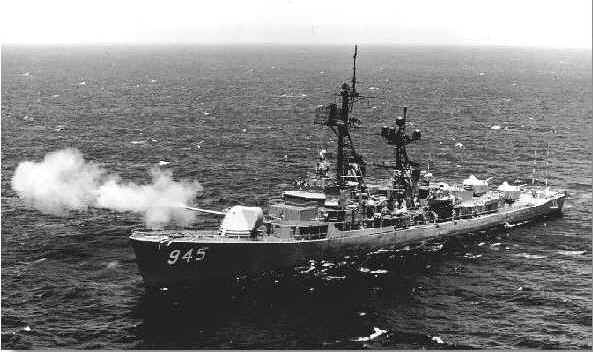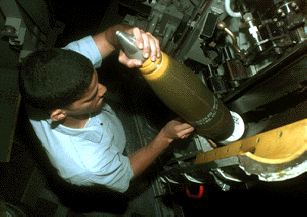Since the retirement of all four battleships with a total of 36 16-inch (406mm) guns, the US Navy is left with small 5-inch (127mm) guns (below) on today's cruisers and destroyers for naval surface fire support. Although some money is provided for research each year to quiet the Marines and other critics, other Navy programs always take priority when it comes to providing large sums for procurement.
 The
US Navy planned to equip its future destroyers with a 155mm naval gun that promised a range of 60-100
miles. This failed as the new 155mm (6.1 inch) guns mounted on the
Zumwalt class have a range of less than 60 miles, and the rocket propellant needed to reach
this far and
the guidance system leaves little room for explosives in the projectile. The Navy
tested a 5-inch (127mm) Extended Range Guided Munition
(ERGM) for a decade with
poor results. Its projectile was mostly guidance and rocket
propellant, so it had room for only 19 lbs of submuntions at a cost of $50,000 a round. ERGMs may be useful against a few high-value targets, but are too expensive for general use, their GPS guidance can be jammed, and their warhead is
far too small.
The
US Navy planned to equip its future destroyers with a 155mm naval gun that promised a range of 60-100
miles. This failed as the new 155mm (6.1 inch) guns mounted on the
Zumwalt class have a range of less than 60 miles, and the rocket propellant needed to reach
this far and
the guidance system leaves little room for explosives in the projectile. The Navy
tested a 5-inch (127mm) Extended Range Guided Munition
(ERGM) for a decade with
poor results. Its projectile was mostly guidance and rocket
propellant, so it had room for only 19 lbs of submuntions at a cost of $50,000 a round. ERGMs may be useful against a few high-value targets, but are too expensive for general use, their GPS guidance can be jammed, and their warhead is
far too small.
As a result, the 155mm gun launches a $100,000 missile with just 24 lbs of explosive. Since the Navy recently limited the Zumwalt class to three and returned to buying Burkes with 5-inch (127mm) guns, it is unclear if the Navy will foolishly retain 155mm guns on just three ships with a training and parts pipeline along with an entire class of 155mm ammo, which is not compatible with 155mm ammo used by the Army and Marines.
The solution is for the Navy to modernize the proven Mk-71 8-inch (203mm) gun. This gun was successfully tested aboard the USS Hull in the 1970s (below). Although the shock and the weight of the MK-71 strained that ship, the newer DDG-51 Arleigh Burke class destroyers are twice its size. A Navy study determined they can fit a modernized MK-71 on the Burkes, but the Navy shelved this opportunity in favor of a 155mm missile launcher called a gun.

The MK-71 8-inch gun can deliver the firepower of three 5-inch guns, and much longer ranges are possible by procuring the MK-63 8-inch projectile. This was an upgraded German "Arrow" projectile from WWII, with a long, pointed nose and a sabot sleeve that achieved a range of 41 miles when fired during the Vietnam conflict. However, an improved aerodynamic shape called "base bleed" later developed by Dr. Gerald Bull for 175mm projectiles can add a few more miles by reducing drag. The MK-63 projectile weighed 115 pounds (the average 8-inch HE round weighs 260 pounds) and was used against Viet Cong base camps deep in the interior of the country with good success. Unfortunately, the Navy did not fully develop the round combination (projectile and powder) and the resulting range error was about 250 yards, which is outside the lethal effect of the round. By simply determining a better powder match to the projectile the Navy could have cut that range error down to around 80 yards. Multiple rounds can reduce this error considerably to meet engagement requirements.
 This 8-inch projectile provides triple the range of 5-inch guns at considerably less cost than any weapon proposed today.
Naval gunfire is needed to provide FIREPOWER to blast enemy defensive positions.
An MK-71 firing twelve 8-inch rounds within one minute can provide far greater firepower at a far lower cost than expensive guided munitions.
This is important because the exact location of the enemy is often unknown, so
guns blast suspected locations.
This 8-inch projectile provides triple the range of 5-inch guns at considerably less cost than any weapon proposed today.
Naval gunfire is needed to provide FIREPOWER to blast enemy defensive positions.
An MK-71 firing twelve 8-inch rounds within one minute can provide far greater firepower at a far lower cost than expensive guided munitions.
This is important because the exact location of the enemy is often unknown, so
guns blast suspected locations.
The Navy should incorporate an 8-inch gun into the design of future destroyers and cruisers and begin procurement of 8-inch guns to backfit on the Burke class destroyers. The Navy does not need to research this subject, it needs to buy MK71/60 8-inch guns. To ensure support, 5-inch and 8-inch replica shells should be placed on display in Pentagon and Congressional corridors so decision makers can see why 260 lb 8-inch rounds can provide 350% more firepower than the small 70 lb 5-inch round. (above) More details about this gun can be found in two articles published in the US Naval Institute's Proceedings: Nov '92 p.104 and Nov '94 p. 94.
©2015 www.G2mil.com